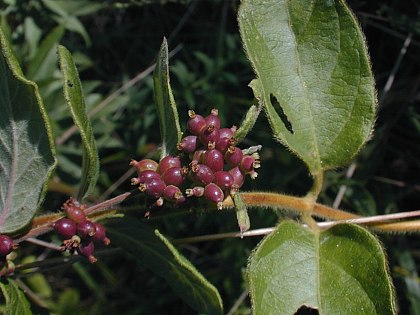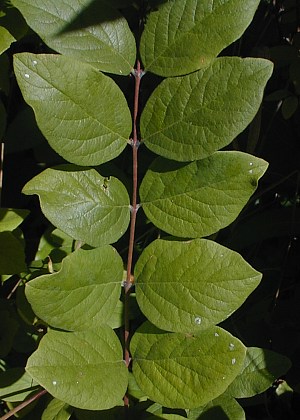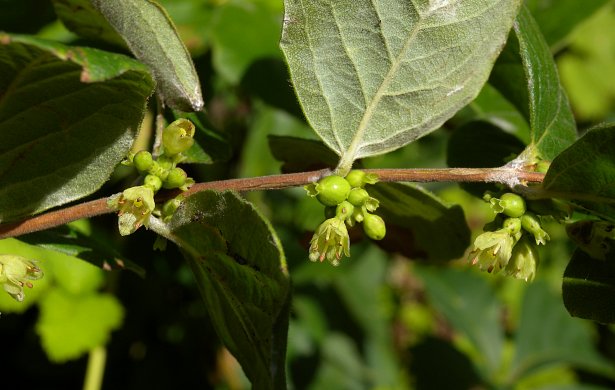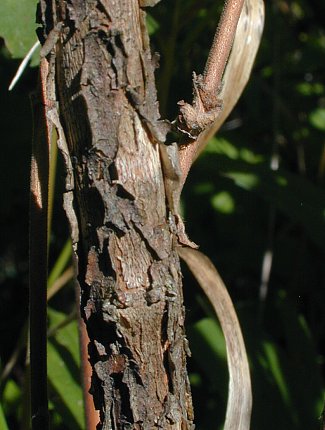Description: This branching shrub is 2-4' tall. The trunk and lower branches are woody and brown; they are covered with strips of loose shaggy bark. The middle to upper branches are reddish purple to brown and variably hairy. The blades of the opposite leaves are up to 2" long and 1¼" across; they are oval-ovate and smooth along their margins. The upper surface of each leaf blade is medium green and hairless to slightly pubescent, while the lower surface is whitish green and slightly pubescent to very pubescent. Each leaf has a short petiole up to ¼" long. Leaf venation is pinnate.

At the axils of some leaves, there develops dense clusters of greenish yellow flowers that are sessile, or nearly so. Each flower is about ¼" long, consisting of a short tubular corolla with 5 lobes, a short green calyx with 5 teeth, and an inferior ovary that is pale green and globoid-ovoid in shape. Inside the corolla, there are 5 stamens surrounding a hairy style. The blooming period occurs during the late spring or summer. Each flower is replaced by a berry containing 2 seeds. The mature berries are about ¼" long, reddish purple, and ovoid-globoid in shape; the texture of their flesh is somewhat dry. The seeds are oblongoid and flattened. The root system consists of a woody branching taproot.

Cultivation:
Coralberry adapts to partial sun, moist to dry conditions, and a loamy
or rocky soil.
Range & Habitat:
The native Coralberry is occasional to locally common in the southern
half of
Illinois, becoming less common or absent in the northern half of the
state (see Distribution
Map). Habitats include thin rocky woodlands, woodland
openings, woodland borders, areas along woodland paths, powerline
clearances in wooded areas, thickets, and limestone glades. Sometimes
this shrub is grown as an ornamental plant in gardens, from which it
occasionally escapes. Disturbance in wooded areas is beneficial if it
reduces excessive shade from overhead trees.

Faunal
Associations:
The flowers attract bees, wasps, and flies primarily. These insects
suck nectar from the flowers, although some of the bees also collect
pollen. The caterpillars of the moths Hemaris diffinis
(Snowberry Clearwing), Hemaris thysbe (Hummingbird
Clearwing), and Hesperumia sulphuraria (Sulfur
Moth) feed on the foliage of Coralberry and other Symphoricarpos
spp. The aphid Apathargelia symphoricarpi
and the thrips Thrips winnemanae suck juices from
the undersides of the leaves. The berries persist into the fall and
winter and are eaten primarily by Robins (Turdus migratorius); the buds
and berries are also eaten by the Bobwhite. Coralberry is a favorite
food plant of the White-Tailed Deer and it is often heavily browsed.
Because of its dense branching habit and abundant leaves, this shrub
provides good cover for wildlife.
Photographic Location:
A powerline clearance at Busey Woods in Urbana, Illinois.

Comments: Coralberry is a rather small sprawling shrub with attractive foliage and berries. It is an easy shrub to identify in natural areas, particularly during the fall, because of the purplish red berries. Other Symphoricarpos spp. (Snowberry, Wolfberry) in Illinois have white or greenish white berries. A related group of plants, Lonicera spp. (Honeysuckles), are either vines or upright shrubs. Like Coralberry, Honeysuckles often produce berries in clusters near the leaves, but their berries are usually bright red and more juicy. Generally, the corollas of Honeysuckle flowers are larger in size than those of Coralberry, and they have long slender lobes. All of these plants produce pairs of opposite leaves on woody stems; the margins of their leaves are smooth or slightly wavy, but they never have teeth, unlike the leaves of many other shrubs. Another common name of Symphoricarpos orbiculatus is Buckbrush, which refers to the attractiveness of this shrub to deer as a food plant.